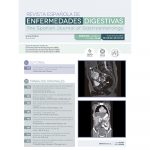The use of serum calprotectin as a biomarker for inflammatory activity in inflammatory bowel disease
 INTRODUCTION:
INTRODUCTION:
simple, reliable and non-invasive biomarkers are needed to enable the early detection of inflammatory activity for the correct management of inflammatory bowel disease (IBD). One of these biomarkers may be serum calprotectin (SC).
MATERIAL AND METHODS:
a prospective study was performed of patients with IBD due to undergo a colonoscopy as part of the common clinical practice. The study parameters included SC, fecal calprotectin (FC) and conventional blood test parameters. Clinical indices (Harvey and Walmsley) and relevant endoscopic scores were completed for each scenario (Simple Endoscopic Score Crohn Disease [SES-CD] and Mayo).
RESULTS:
fifty-three patients were included in the study, 51% (27 patients) with ulcerative colitis (UC) and 49% (26 patients) with Crohn’s disease (CD). The CS values in UC were significantly higher with an endoscopic Mayo score 2/3 (median score 10.39 mg/ml [IQR: 7.4-12.2]) compared to those with a Mayo score of 0/1 (median 4.07 mg/ml [IQR: 2.9-7.2]) (p = 0.01). The area under the ROC curve (AUCROC) was 0.85 and the sensitivity and specificity were 83.3% and 81.25%, respectively, for a SC cut-off point of 4.4 mg/dl.
Furthermore, a higher AUCROC was obtained in comparison with other serological markers for activity (C-reactive protein [CRP], erythrocyte sedimentation rate [ESR], hemoglobin [Hb] and platelets). There were no statistically significant differences in the comparison between SC and endoscopic findings in CD (SES CD > 3: 20.1 [IQR: 16.8-23.4] vs SESC ≤ 3:6.25 [IQR: 5.4-7.1]) (p = 0.8).
CONCLUSIONS:
SC is a good indirect marker of inflammatory activity and there was a correlation with endoscopic findings in UC. However, there were no statistically significant differences in the case of CD.
Suárez Ferrer C, Abadía Barno M, Martín Arranz E, Jochems A, García Ramírez L, Poza Cordón J, Jaquotot Herranz M, Cerpa Arencibia A, Martín Arranz MD.
Rev Esp Enferm Dig. 2019 Sep 3; 111
doi: 10.17 235/reed.2019.5797/2018.
